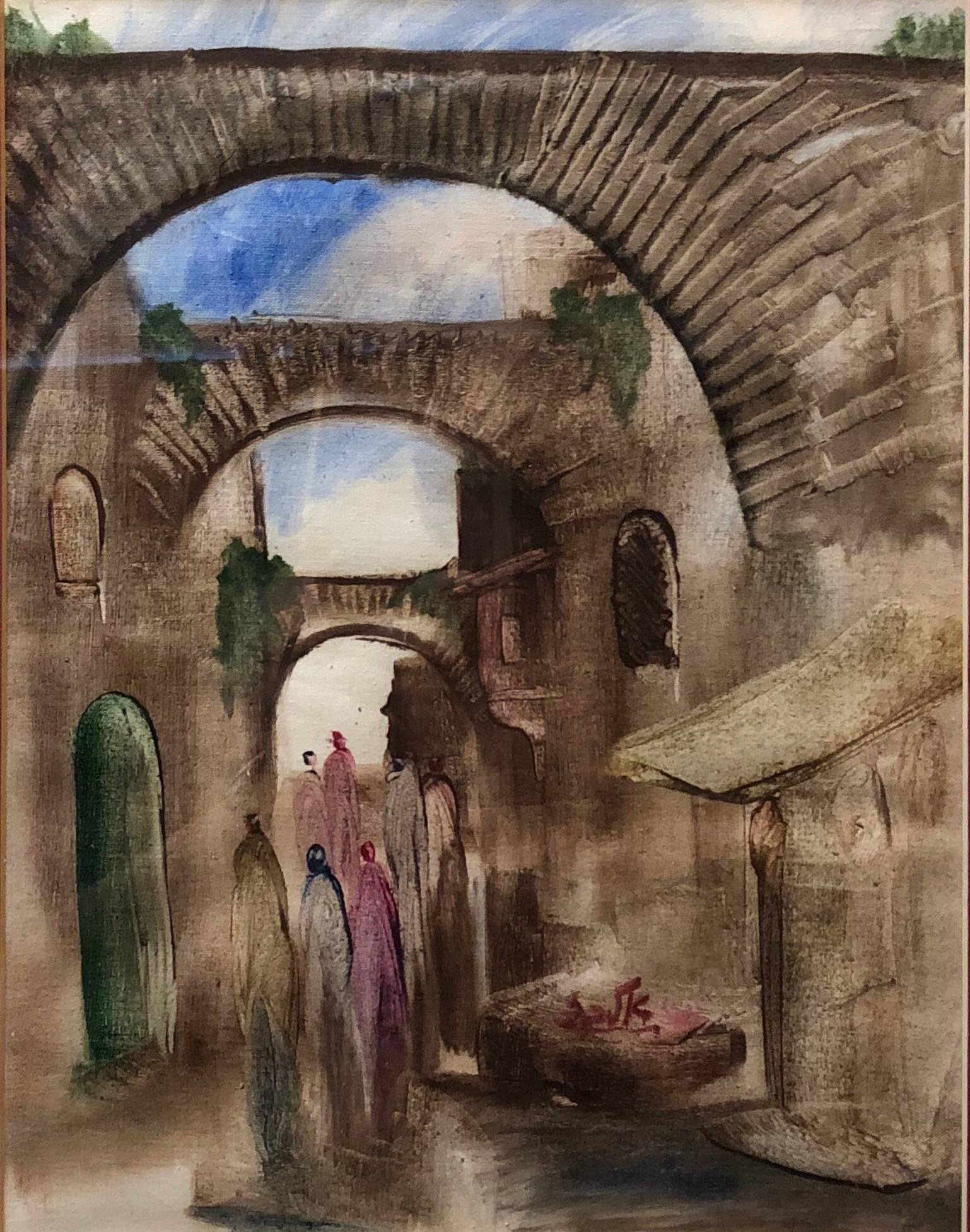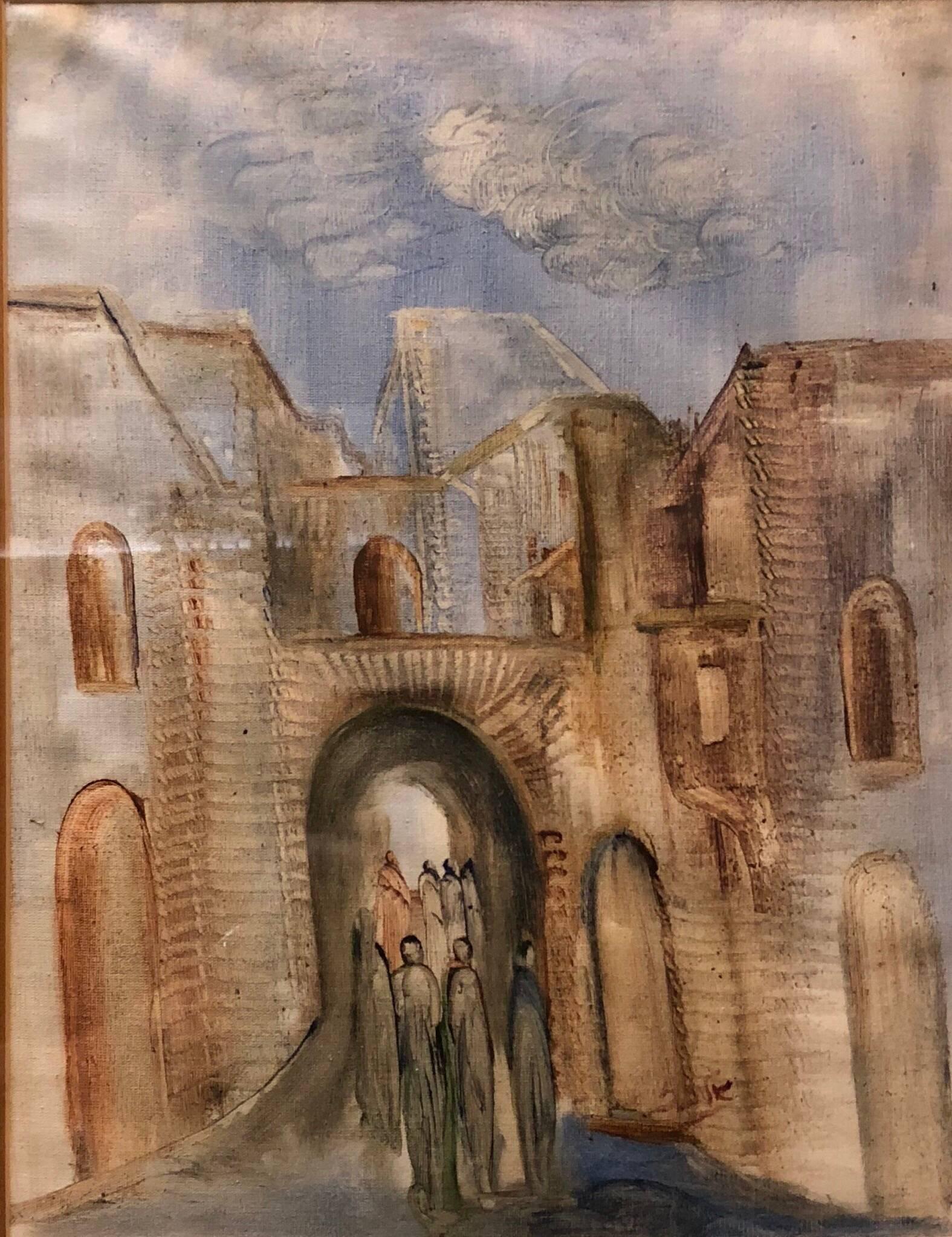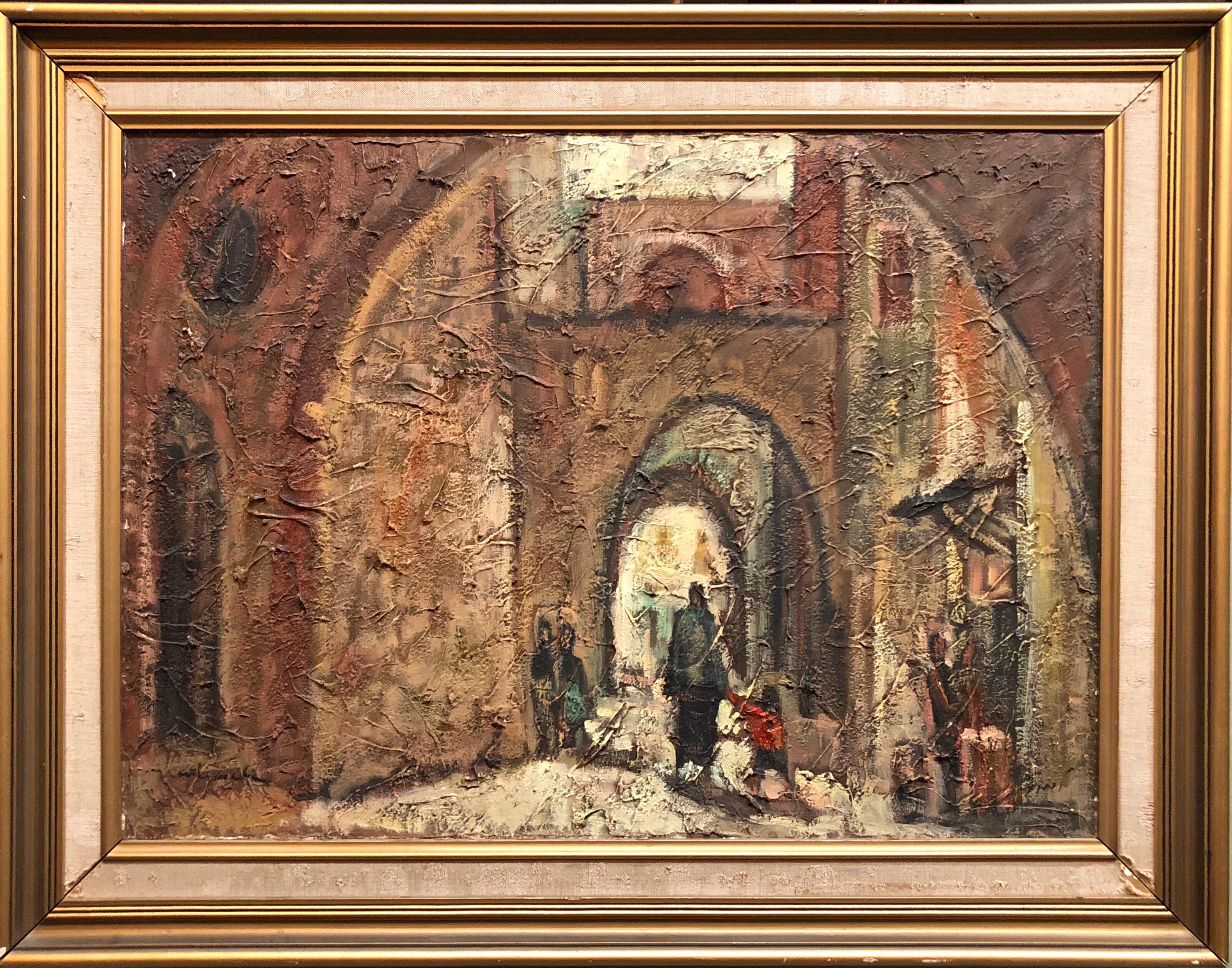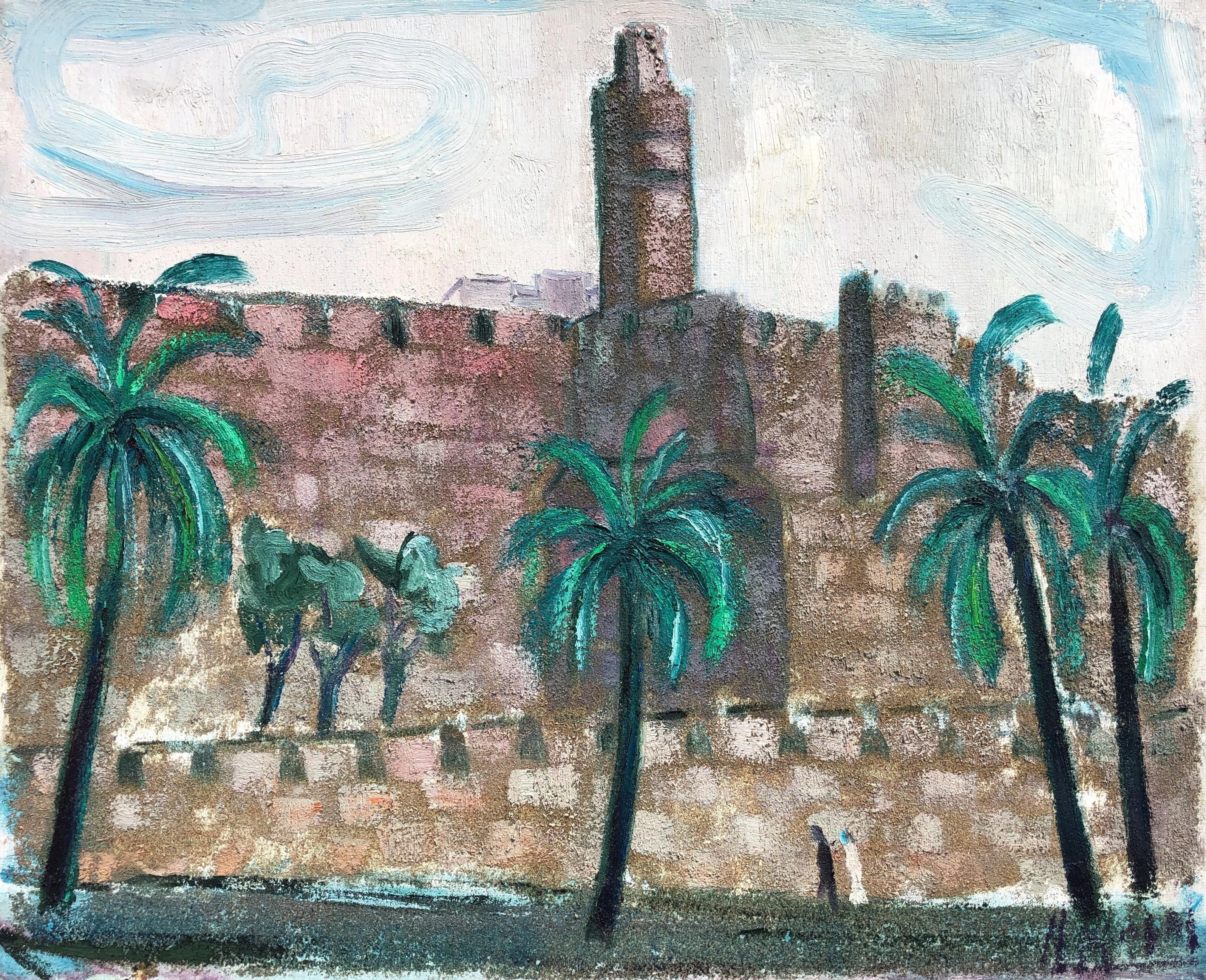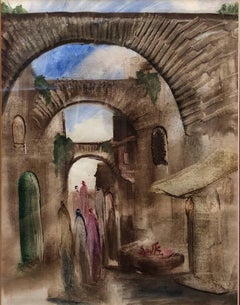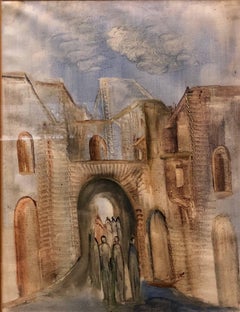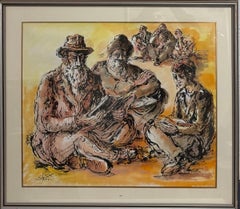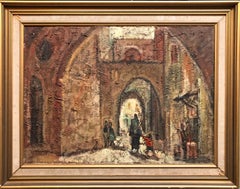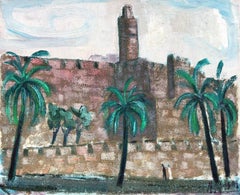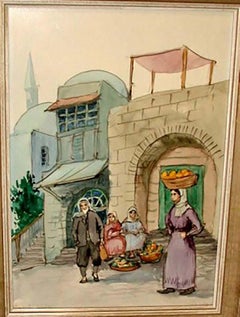Items Similar to Old City Jerusalem City Walls landscape Scene Painting, Judaica
Want more images or videos?
Request additional images or videos from the seller
1 of 8
Jossi SternOld City Jerusalem City Walls landscape Scene Painting, Judaica
$1,800
£1,366.78
€1,563.02
CA$2,514.86
A$2,797.07
CHF 1,460.55
MX$34,037.42
NOK 18,653.39
SEK 17,493.59
DKK 11,665.40
Shipping
Retrieving quote...The 1stDibs Promise:
Authenticity Guarantee,
Money-Back Guarantee,
24-Hour Cancellation
About the Item
Vibrant Gouache and watercolor painting by Israeli master JOSSI STERN. on paper mounted to board. 31x34.75, 23.5x27.5 without frame.
Hungary, b. 1923, d. 1992
Jossi (Yossi) Stern, son of David and Katerina, was born in the Bakon Hills of Hungary, in 1923. He was already drawing when at the age of ten he moved with his family from the Bakon Hill region to the considerably more cosmopolitan Budapest.
Recognizing the looming threat of Hitler and the pending Nazi invasion of Hungary, in 1940, at the age of seventeen, the young artist made his way to Palestine aboard the Sakaria, an old ship heavily crowded with 2,300 other refugees. Before reaching the shores of Palestine, then under the British Mandate, the British Navy intercepted the ship and declared Stern and all those aboard illegal immigrants. Stern was sent to a prison camp where he remained incarcerated by the British for six months.
In 1943, having spent a few years doing agricultural work, Stern was encouraged by close friends who recognized his artistic talent to enroll in the prestigious Bezalel School of the Arts in Jerusalem. An outstanding student, he eventually became a highly respected teacher of Graphic Arts at Bezalel.
Stern is recognized in Israel as having been one of the country's premier artists. His drawings are exhibited and appear in many publications and museums worldwide. Stern was the recipient of numerous awards including the Jerusalem Medal as well as both the UNESCO and Herzl Prize.
He was included in the exhibition New Bezalel Artists' House, Jerusalem Tel Aviv Museum, along with Artists:
Ludwig Wolpert, Joseph Budko, Gershon Knispel, Gershon Avigdor Arikha, Maryan, Jacob Steinhardt, Ruth Schloss, Mordecai Ardon, Naftali Bezem.
He studied art at the Bezalel Academy of Art and Design, the Royal Academy of Art in London and on his own in Paris. He was Professor of Graphic Arts at the Bezalel Academy of Art and Design, a position he held for more than twenty years.
- Creator:
- Dimensions:Height: 31 in (78.74 cm)Width: 34.75 in (88.27 cm)
- Medium:
- Movement & Style:
- Period:
- Condition:
- Gallery Location:Surfside, FL
- Reference Number:1stDibs: LU38212739342
About the Seller
4.9
Platinum Seller
Premium sellers with a 4.7+ rating and 24-hour response times
Established in 1995
1stDibs seller since 2014
1,784 sales on 1stDibs
Typical response time: <1 hour
- ShippingRetrieving quote...Shipping from: Surfside, FL
- Return Policy
Authenticity Guarantee
In the unlikely event there’s an issue with an item’s authenticity, contact us within 1 year for a full refund. DetailsMoney-Back Guarantee
If your item is not as described, is damaged in transit, or does not arrive, contact us within 7 days for a full refund. Details24-Hour Cancellation
You have a 24-hour grace period in which to reconsider your purchase, with no questions asked.Vetted Professional Sellers
Our world-class sellers must adhere to strict standards for service and quality, maintaining the integrity of our listings.Price-Match Guarantee
If you find that a seller listed the same item for a lower price elsewhere, we’ll match it.Trusted Global Delivery
Our best-in-class carrier network provides specialized shipping options worldwide, including custom delivery.More From This Seller
View AllJerusalem Old City Landscape, Expressionist Judaica Israeli Painting
By Andre Elbaz
Located in Surfside, FL
In this painting the artist uses gestural brushstrokes, which causes distortion and exaggeration for emotional effect. Andre Elbaz uses as his subject figures walking in old city Jerusalem.
André Elbaz (born April 26, 1934, El Jadida, Morocco) is a famous Moroccan painter and filmmaker.
Elbaz studied art and theatre in Rabat and Paris from 1950 to 1961. He started painting only at the age of 21, until which age he had been interested mainly in theatre. A few years later, he managed to combine his two passions into a new approach in art-therapy, inventing together with his wife, a psychiatrist, the Pictodrame, which brought him world recognition.
His first exhibition, which was very successful, took place in Casablanca in 1961 and earned him an appointment as Professor at the Beaux-Arts school in Casablanca. Years later, in 1976, he exhibited his paintings at the Tel-Aviv Museum.
In parallel to his career as a painter, Elbaz is also known as a filmmaker. He produced several short films in France, Canada and the United States. One of them, La nuit n'est jamais complète (The night is never complete), won a prize at the "5th Biennale de Paris in 1967". Among the themes chosen for the many films he produced, there was a short one about the Warsaw Ghetto uprising, as well as a series of drawings entitled Seuls (Alone), with texts written by both Elie Wiesel...
Category
20th Century Expressionist Figurative Paintings
Materials
Paper, Gouache
Jerusalem Old City Landscape, Expressionist Judaica Israeli Painting II
By Andre Elbaz
Located in Surfside, FL
In this painting the artist uses gestural brushstrokes, which causes distortion and exaggeration for emotional effect. Andre Elbaz uses as his subject figures walking in old city Jerusalem.
André Elbaz (born April 26, 1934, El Jadida, Morocco) is a famous Moroccan painter and filmmaker.
Elbaz studied art and theatre in Rabat and Paris from 1950 to 1961. He started painting only at the age of 21, until which age he had been interested mainly in theatre. A few years later, he managed to combine his two passions into a new approach in art-therapy, inventing together with his wife, a psychiatrist, the Pictodrame, which brought him world recognition.
His first exhibition, which was very successful, took place in Casablanca in 1961 and earned him an appointment as Professor at the Beaux-Arts school in Casablanca. Years later, in 1976, he exhibited his paintings at the Tel-Aviv Museum.
In parallel to his career as a painter, Elbaz is also known as a filmmaker. He produced several short films in France, Canada and the United States. One of them, La nuit n'est jamais complète (The night is never complete), won a prize at the "5th Biennale de Paris in 1967". Among the themes chosen for the many films he produced, there was a short one about the Warsaw Ghetto uprising, as well as a series of drawings entitled Seuls (Alone), with texts written by both Elie Wiesel...
Category
20th Century Expressionist Figurative Paintings
Materials
Paper, Gouache
Old City Jerusalem City Walls landscape Scene Painting, Judaica
By Jossi Stern
Located in Surfside, FL
Vibrant Gouache and watercolor painting by Israeli master JOSSI STERN. on paper mounted to board.
Dimensions: 29.5 X 33.5 23 X 27
Jossi (Yossi) Stern, (Hungarian Israeli 1923 - ...
Category
20th Century Modern Figurative Paintings
Materials
Watercolor, Gouache, Illustration Board
Jerusalem Old City Cityscape Israeli Modernist Oil Painting Signed in Hebrew
Located in Surfside, FL
Signed Nathanson. Could be the famous artist Avraham Naton (Natanson) I am not certain. it is a very lovely Modernist Israeli landscape.
Avraham Naton (Natanson), Israeli, born in Bessarabia, 1906-1959. Avraham Naton was born in Rani, Bessarabia to a large secular family. In 1935, after Art studies in Romania, he immigrated to the Land of Israel and settled, first, in Givat Haim and later in Ramat Gan. From the 1940s he worked as an Art teacher in Ramat Gan and Givataim. In 1948 he worked as an illustrator at BaMahane Newspaper. He was one of the Founders of New Horizon Group. Between 1952-1959 he was a member of the Milo Club and served as the club secretary.
Education
1930-33 Art Academy, Bucharest, Romania
Teaching
1940's Ramat Gan and Givataim
Awards And Prizes
Jerusalem Prize for Painting and Sculpture
1942 Dizengoff Prize
1953 Milo Club Prize
New Horizons, The Ofakim Hadashim art movement began with a group of artists who mounted an exhibition in Tel Aviv's Habima national theater in December 1942, under the name "The Group of Eight". The group evolved into a coherent artistic movement only after the founding of the state of Israel in 1948. Members of the school included Arie Aroch, Zvi Meirovitch, Avraham Naton (Natanson), Avigdor Stematsky and Yehezkel Streichman. The work of sculptor Dov Feigin also appeared in the catalog of the 1942 exhibition, though it was not displayed. In February 1947 five of the original members of the group joined Joseph Zaritsky...
Category
1950s Modern Landscape Paintings
Materials
Canvas, Oil
The Old City of Jerusalem
Located in Surfside, FL
Pencil signed artists proof lithograph or serigraph. Shmuel Katz (Hebrew: שמואל כ"ץ) (August 18, 1926 – March 26, 2010) was an Israeli artist, illustrator, and cartoonist. A Holocau...
Category
20th Century Modern Landscape Prints
Materials
Lithograph
German Israeli Oil Painting Jerusalem Panorama of Old City Walls
By Arye Leo Peysack
Located in Surfside, FL
German-Israeli artist ARYE LEO PEYSACK (1894-1972). Peysack was born in 1894 and trained in Germany. He immigrated to Palestine in the early 1920s, traveled extensively around the co...
Category
Early 20th Century Impressionist Landscape Paintings
Materials
Oil
You May Also Like
Jerusalem wall urban landscape original oil on canvas painting
By Manuel Capdevila Massana
Located in Barcelona, Barcelona
Unframed
Manuel Capdevila i Massana (Barcelona, December 28, 1910 - April 18, 2006) was a Catalan painter and goldsmith, son of the goldsmith Joaquín Capdevila y Meya and father of the also goldsmith, Joaquim Capdevila y Gaya.
In 1950 he was invited to The 1950 Pittsburgh International contest at the Carnegie Institute, Pennsylvania, where he presented the painting The Priest, which is currently part of the MNAC collection. A year later the Museum of Modern Art in Panama acquired the work Crisantemos.
He was part of the Morera Prize Jury in 1953. Two years later he signed the manifesto that Alexandre Cirici drafted, creating the Institute of Industrial Design, as a member of the IDIB Management Board of Directors.
At the request of Lluís Maria Güell, director of the Massana School, he assumed the creation of the Open Jewelery Classroom in 1959, from where he made students think and reflect on the new possibilities of contemporary jewelry. He establishes contacts with the Kunst Werkschule in Pforzheim, a pioneering school...
Category
1980s Fauvist Landscape Paintings
Materials
Oil, Canvas
View of Jerusalem, Framed Impressionist Landscape Oil Painting
Located in Long Island City, NY
Artist: Unknown XXth Century
Title: View of Jerusalem
Medium: Oil on canvas, signed and titled in Hebrew
Image Size: 19.5 x 26.5 in. (49.53 x 67.31 cm)
Frame Size: 25 x 32 inches
Category
Mid-20th Century Modern Landscape Paintings
Materials
Oil, Canvas
Jerusalem Street Scene
Located in Fort Washington, PA
Medium: Watercolor on Board
Signature: Signed Lower Left
Jerusalem Street Scene
Category
20th Century Landscape Drawings and Watercolors
Materials
Watercolor, Board
Impressionist Landscape Painting of the Holy City of Jerusalem
By Frank Freed
Located in Houston, TX
Lovely impressionistic painting of the Holy City of Jerusalem by Texas artist Frank Freed.
Dimensions of painting itself: H 18 in. x W 24 in.
Artist Biog...
Category
1960s Impressionist Landscape Paintings
Materials
Acrylic
Jerusalem by Ludwig Blum, landscape painting, figurative art
By Ludwig Blum
Located in London, GB
Jerusalem by Ludwig Blum
Oil on canvas
18 x 28.7 inches / 45.7 x 73cm
Signed
Painted circa 1955
Category
1950s Naturalistic Landscape Paintings
Materials
Oil, Canvas
Jerusalem
By Ernst Huber
Located in Jerusalem, IL
"Jerusalem view" by Austrian painter Ernst Huber. The painting with a deep perspective presents the view downward on the city in the motion. We share the...
Category
Mid-20th Century Academic Landscape Paintings
Materials
Canvas, Oil
